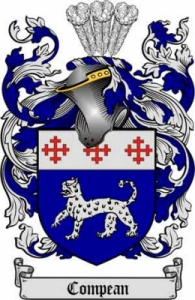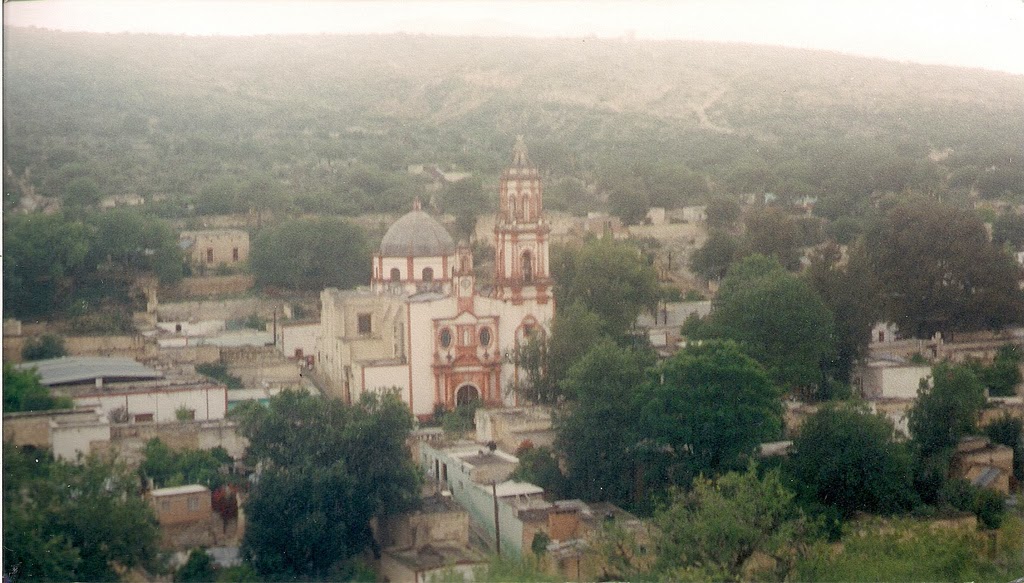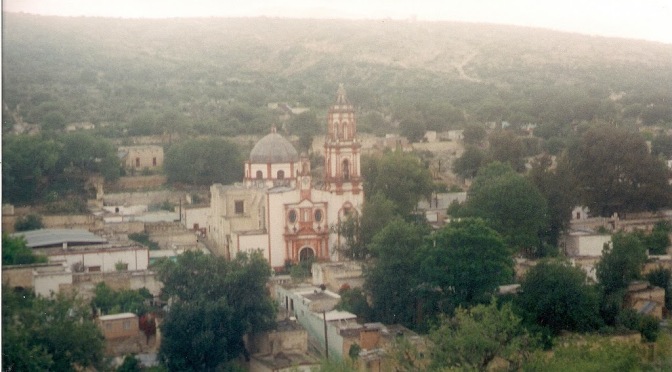 My 15th entry in Amy Johnson Crow’s “52 Ancestors in 52 Weeks” family history blogging challenge for 2015.
My 15th entry in Amy Johnson Crow’s “52 Ancestors in 52 Weeks” family history blogging challenge for 2015.
The challenge: have one blog post each week devoted to a specific ancestor. It could be a story, a biography, a photograph, an outline of a research problem — anything that focuses on one ancestor.
Amy’s 2015 version of this challenge focuses on a different theme each week.
The theme for week 15 is — How Do You Spell That? What ancestor do you imagine was frequently asked that? Which ancestor did you have a hard time finding because of an unusual name?
My 15th ancestor is my 4th great-grandfather, Jose Victoriano Compean (b. abt. 1803). Jose Victoriano is the oldest identified ancestor in my paternal Compean line. I do not know much about Jose Victoriano — not even where in Mexico he was born, nor the names of his parents or siblings.
His name isn’t difficult to spell or to pronounce. It is not an unusual name for a Mexican-born male. So why him for this particular challenge? Because of how difficult Mexican naming conventions can make genealogical research, and how easy Mexican naming conventions can make genealogical research. My 4th great-grandfather Jose Victoriano Compean and his family are a very good representation of this dichotomy.
Mexican Surnames
When dealing with Mexican names one must be mindful of the traditional Spanish naming convention of using dual surnames. In Mexico, the dual surname consists of both parents’ surnames: the paternal surname (apellido paterno), followed by the maternal surname (apellido materno). This means that Mexican wives do not take on the surname of their husbands upon marriage. In Mexican records, they remain identified by their maiden names (paternal, maternal).
So within the traditional Mexico household, there can be at least three sets of surnames for a single family: the husband’s dual surnames, the wife’s dual surnames, and a combination of their surnames used as dual surnames for each child.
Upon immigration to the U.S., all sorts of different surname scenarios end up in the records. Often the wife is recorded now just under a single surname — that of her husband. Sometimes a male is recorded under just a single surname (a crapshoot if it’s the paternal or maternal one). Both of which can make it difficult to try to find a paper trail back in Mexico.
Mexican Given Names
It wasn’t until a few years ago that I became aware of another traditional naming convention — multiple first names. I thought that the string of names found on ancestral records was a first name with one, two, or sometimes three middle names. Not the case with Mexican names. Mexican naming conventions do not employ the concept of a middle name.
Often the first of the given names is in honor of a saint or biblical figure, such as Maria/Mary or Jose/Joseph — which seem to be the two most common such names among my ancestors and their children. According to the FamilySearch Wiki, “In Mexico the child was usually called by the second or third name given at baptism, especially if the first name was María or José.”
Names of Jose Victoriano’s Family
Reviewing the names found in records for my 4th great-grandfather’s children and grandchildren exemplifies these traditional Mexican naming conventions.
I sometimes find Jose Victoriano Compean identified just as Victoriano Compean. I also find his paternal surname spelled Compian (including on records for his children). What I have not found so far is a record referencing his dual surnames, which is very odd for early to mid-1800s Mexico church records.
His Wife
Jose Victoriano Compean married Maria Ignacia Martines, my 4th great-grandmother. Like with Victoriano, I do not yet find Maria Ignacia recorded with two surnames in the traditional Mexican fashion. Only with the single surname, which I assume is her paternal surname, particularly since the name Martines/Martinez was usually included as part of her children’s surnames in church records. Sometimes Maria Ignacia is found under the spelling of Maria Ygnacia, with her paternal surname spelled with a “z”, as Martinez, and also as just Ygnacia Martinez (no Maria).
I do not yet know when and where Jose Victoriano and Maria Ignacia married. It seems likely they were married shortly before 1840, the estimated birth year of their first baptized child. I think it also likely they married at San Isabel church, where three of their four children were baptized, in the municipality of Armadillo de los Infante, San Luis Potosi, Mexico.

Their Children
So far I have identified four children for Victoriano and Ignacia.
- Jose Santiago Compean (b. abt. 1840). My 3rd great grandfather. Also found under Jose Santiago Compean Martinez, and just Santiago Compean.
- Maria Felisitas Compean (b. abt. 1843). Also found under Maria Felisitas Compean Martinez.
- Jose Calisto Compean (b. abt. 1848 ). Also found under Jose Calisto Compean Martinez.
- Jose Cipriano Compean (b. abt. 1857). Also found under Jose Cipriano Compean Martinez.
Although Victoriano and Ignacia had at least four children, in this blog post, I am only focusing on one of those children. My 3rd great-grandfather Jose Santiago Compean is the oldest child I have identified. Known by our family as just Santiago, I learned of this ancestor’s name when my father contacted the cemetery at which Santiago’s daughter Aurelia is buried. Aurelia’s burial records identify her parents as Santiago Compean and Eutimia Sanches. Further research into Mexican church records revealed Santiago and Eutimia’s full given names — with the traditional Jose and Maria.
Maria Eutimia Sanches Nieto (b. 1835), my 3rd great-grandmother, married Jose Santiago Compean on 14 September 1859 at San Isabel church in Armadillo de los Infante, San Luis Potosi, Mexico. The same church where both were baptized as infants. Eutimia can also be found under just her paternal surname, Sanches.
Their Grandchildren
I have identified three children born to Santiago and Eutimia, all daughters.
- Maria Aurelia Compean (1858-1963). My 2nd great-grandmother. Also found under Aurelia Compean.
- Maria Francisca Compean Sanchez (b. abt. 1862).
- Maria Pilar Compean (b. abt. 1865).
One of Aurelia’s daughters became my great-grandmother, Maria Hermalinda Nieto Compean (1887-1974). Maria was the only first name I ever knew for my Nana — no one in our family ever knew her as Hermalinda. So when I first discovered that her mother Aurelia’s full first name was Maria Aurelia, and that her grandmother Eutimia’s full first name was actually Maria Eutimia, I naively assumed each mother had simply passed down her own first name to these daughters, and chose to go by a middle name.
Why the Dichotomy?
I mentioned at the beginning of this post the dichotomy of how difficult Mexican naming conventions can make genealogical research, and how easy Mexican naming conventions can make genealogical research.
Because of the inconsistencies in how our Mexican ancestors’ names are recorded on various records and transcriptions (for both Mexico and U.S. records), it can make identifying which type of surname is being used — the maternal, paternal, or for females even their husband’s surname — a bit of a nightmare. Even in FamilySearch, transcriptions of the same records can inconsistently use given names and surnames for the same individuals — I usually find this occurring in different indexing projects for the same records.
On the other hand, knowing how this dual-surnames convention works among Mexican records, researchers can immediately identify the surnames of an ancestor’s parents. For a female ancestor, that would be immediate identification of her father’s surname and her mother’s surname — something that in Anglo records we usually cannot readily identify if a female ancestor is referenced only by her married surname. For Anglo male ancestors, we usually assume that ancestor shares the same surname as his father. But in Mexican records, we often are able to also identify the paternal surname (what we call a maiden name) for that male ancestor’s mother.
Understanding now about multiple first names, especially saints’ names, when I see a record for a Mexican-born ancestor that simply uses the first name Maria/Mary or Jose/Joseph, I immediately begin to look for clues to a more complete given name.
But sometimes those clues are just not there, and I end up with a brick wall ancestor like my great-grandfather Jose/Joseph Robledo (1875-1937) — who immigrated to the U.S. with his wife Maria Hermalinda Nieto Compean and their two oldest children. Jose or Joseph is the only name by which his children or grandchildren ever knew him. No records found identify a second first name. And yet, according to that FamilySearch Wiki article, Mexican males rarely went by Jose as a first name.
Among my fellow Hispanic genealogists, the listservs and forums are packed with folks lamenting about how difficult it is to make Mexican naming conventions fit into the confines of predominantly Anglo-designed genealogy databases, such as Ancestry Member Trees. It is like trying to squeeze a square peg into a round hole. Ancestry.com has a field titled “First and Middle Name” and one titled “Last Name” (singular). Do we put the full dual surname in the Last Name field? Or is that going to mess up possible searches and hints? FamilySearch, who has a more global focus, handles these field names better in its Family Tree — “First Names” (instead of first and middle), but still only a “Last Name” (singular) field.
As with any of our ancestors, it is critical that we genealogists take the time to learn and understand the conventions used in an ancestor’s country of origin, culture, religion, and various places of residence.
Sources Consulted
- Aaron. (2011, July 18). Spanish Naming Conventions — Part 1: The Basics [Blog]. Retrieved from http://blog.myheritage.com/2011/07/spanish-naming-conventions-%E2%80%93-part-1-the-basics/
- Hispanic American naming customs. (2015, February 18). In Wikipedia, the free encyclopedia. Retrieved from http://en.wikipedia.org/w/index.php?title=Hispanic_American_naming_customs&oldid=647648691
- Mexico Names, Personal. (n.d.). In FamilySearch Wiki. The Church of Jesus Christ of Latter-Day Saints. Retrieved from https://familysearch.org/learn/wiki/en/Mexico_Names,_Personal
- Spanish naming customs. (2015, April 18). In Wikipedia, the free encyclopedia. Retrieved from http://en.wikipedia.org/w/index.php?title=Spanish_naming_customs&oldid=657063765
[contentblock id=44 img=html.png]
